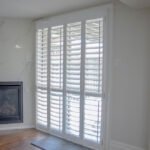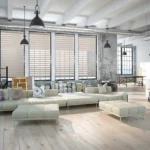Introduction
In the world of interior design and home construction, every detail matters. That’s why we’re delving deep into the nuances of wood vs. vinyl shutters, revealing five significant differences that are essential for professionals in the industry to consider. From composition to health risks, structural integrity, design options, and appreciation value, we’ll provide insights that will help you make informed decisions for your projects.
Wood vs Vinyl Shutters: Exploring Key Differences
When it comes to choosing the perfect window treatment for your home, the options can be overwhelming. Among the myriad choices available, two contenders stand out: wood and vinyl shutters. Both offer distinct advantages and cater to various preferences, making it crucial to understand their fundamental differences.
Welcome to an in-depth exploration of wood vs. vinyl shutters. In this comprehensive guide, we’ll delve into the critical distinctions between these two popular window covering options. Whether you’re an interior designer, a homeowner embarking on a renovation project, or a home builder looking to make informed recommendations to your clients, this knowledge will empower you to make the right choice.
So, fasten your seatbelts as we navigate through the five major differences you didn’t know about wood vs. vinyl shutters, and uncover valuable insights that will help you elevate your interior design game. Let’s embark on this enlightening journey to discover which shutter option aligns best with your needs and preferences.
Table of Contents
Composition: The Building Blocks
Wood Shutters:
- Versatile Wood Choices: Wood shutter manufacturers use a range of woods, including American poplar, pine, oak, cherry wood, and ash, catering to diverse design preferences.
- Quality Matters: Premium-grade wood, carefully selected from straight trees, offers better resistance to warping.
- MDF Alternatives: Medium-density fiberboard (MDF) wood shutter products are common, emulating the look of real wood but lacking the same structural integrity.
Vinyl Shutters:
- PVC Predicament: Vinyl shutters, also known as polyvinyl chloride (PVC) shutters, are manufactured with chemicals and phthalates, which can pose environmental and health risks.
- PVC Pollution: PVC production generates toxic chemical pollutants, including dioxin, hydrochloric acid, and vinyl chloride, contributing to environmental concerns.
- Phthalate Perils: Phthalates used in vinyl shutters can be released into the atmosphere, potentially leading to health issues such as cancer, diabetes, and neurological damage.
Health Risks: Your Well-being Matters
Vinyl Shutters:
- Solar Heat Sensitivity: Vinyl shutters, exposed to solar heat, release phthalates more rapidly, posing health risks.
- Carcinogenic Concerns: The chloroethene monomer in PVC, a known carcinogen, can be present in final PVC shutters, posing health risks throughout their life cycle.
Wood Shutters:
- Paint Protection: High-quality paint on wood shutters provides an effective seal against moisture and heat, ensuring structural integrity.
- Eliminating Emission: Well-sealed wood shutters with good paint quality do not emit harmful gases after the paint cures and hardens.
Structural Integrity: The Backbone of Shutters
Vinyl Shutters:
- Paintless Approach: Vinyl shutters are not covered in paint, relying on colored plastic mixtures for aesthetics.
- Vulnerable to Heat: Lack of paint protection makes vinyl shutters prone to warping and degradation under high heat.
Wood Shutters:
- Robust Paint Seal: High-quality paint forms a seal on wood shutters, protecting them from moisture and heat.
- Material Thickness: Wood shutters are significantly thicker than vinyl shutters, contributing to their durability.
Design Options: Crafting Elegance
Vinyl Shutters:
- Limited Bevel: Vinyl shutters often have basic and modernistic designs due to cost considerations.
- Lack of Variety: Many vinyl shutter manufacturers offer limited design options, restricting variety.
Wood Shutters:
- Versatile Styles: Wood shutters provide a canvas for diverse design options, enhancing visual appeal.
- Expanding Selection: Manufacturers like California Shutters Toronto offer multiple molded wood shutter styles, giving you more choices.
Appreciation Value: Investment That Pays Off
Vinyl Shutters:
- No Value Addition: Vinyl shutters do not enhance a home’s quality and are unlikely to increase its value.
Wood Shutters:
- Value-Boosting Investment: Wood shutters can add to a home’s quality and lead to increased appraisal value.
- Return on Investment: Home appraisers often recognize the value of wood shutters, considering them a worthwhile investment.
Making Informed Choices
As interior designers and home builders, your decisions impact not only aesthetics but also the well-being of occupants and the environment. When choosing between wood and vinyl shutters, prioritize sustainability, health, and design flexibility. Wood shutters emerge as the natural choice, offering durability, variety, and an investment that pays off. Keep in mind that every detail matters, and your commitment to quality will shine through in your projects.
Note: For in-depth discussions on vinyl and wood shutter brands, refer to our article on the top vinyl and polystain shutter brands in Ontario. For more information or assistance in selecting the ideal shutters for your projects, contact us at (416) 230-1043, and our experts will guide you.
Additional Differences Between Wood and Vinyl Shutters
In the world of interior design and home construction, even the subtlest details can make a significant impact. As we explore the distinctions between wood and vinyl shutters, it’s essential to consider every facet of these window coverings. Here are more differences that professionals in the industry should take into account:
**1. Durability and Longevity:
- Wood Shutters: When maintained properly, wood shutters can last for decades, and their structural integrity remains intact.
- Vinyl Shutters: Vinyl shutters, while initially affordable, may not withstand the test of time as well as wood shutters. They can become brittle and faded over the years, requiring replacement.
**2. Customization Options:
- Wood Shutters: Wood’s versatility allows for intricate designs, custom paint or stain finishes, and even unique shapes, making them ideal for creating a bespoke look.
- Vinyl Shutters: Vinyl shutters, due to their manufacturing limitations, offer limited customization options. Creating intricate designs or custom finishes can be challenging.
**3. Environmental Impact:
- Wood Shutters: Sourced from responsibly managed forests, wood shutters are a sustainable choice that contributes to forest conservation efforts.
- Vinyl Shutters: The production of vinyl shutters involves the use of non-renewable resources and the release of harmful chemicals, making them less environmentally friendly.
**4. Aesthetic Appeal:
- Wood Shutters: The natural warmth and texture of wood add timeless elegance to any space, enhancing its overall aesthetic.
- Vinyl Shutters: While vinyl shutters offer a clean and modern look, they may lack the warmth and authenticity of real wood, which some design projects require.
**5. Resale Value:
- Wood Shutters: Homes with well-maintained wood shutters often have higher resale values, as these shutters are perceived as premium features.
- Vinyl Shutters: Vinyl shutters may not contribute as significantly to a home’s resale value, as their longevity and quality are typically lower.
**6. Maintenance Requirements:
- Wood Shutters: Properly sealed and finished wood shutters require minimal maintenance, primarily occasional cleaning and refinishing.
- Vinyl Shutters: Vinyl shutters are relatively low maintenance but may become discolored or brittle over time, necessitating replacement.
**7. Weight and Installation:
- Wood Shutters: Wood shutters tend to be heavier than vinyl shutters due to their thicker construction. This weight may require additional support during installation.
- Vinyl Shutters: Vinyl shutters are lightweight, simplifying the installation process. However, their thinner profiles may affect their durability.
**8. Sound Insulation:
- Wood Shutters: Wood’s natural density provides excellent sound insulation, making wood shutters an ideal choice for reducing external noise.
- Vinyl Shutters: Vinyl shutters may offer less effective sound insulation due to their thinner composition, allowing more sound to penetrate.
**9. Maintenance of Appearance:
- Wood Shutters: Wood shutters may require periodic refinishing to maintain their appearance, especially in humid or high-UV environments.
- Vinyl Shutters: While vinyl shutters are more resistant to environmental factors, they may lose their original luster and color due to sun exposure.
**10. Cost Considerations:
- Wood Shutters: While wood shutters may have a higher upfront cost, their longevity and aesthetic appeal can make them a cost-effective choice in the long run.
- Vinyl Shutters: Vinyl shutters are often more budget-friendly initially but may require more frequent replacements, potentially increasing long-term costs.
Conclusion: Informed Choices for Lasting Impact
As professionals in interior design and home construction, it’s crucial to weigh these additional differences between wood and vinyl shutters when making decisions for your projects. Each aspect, from durability and customization to environmental impact and maintenance, contributes to the overall success of your designs. By considering these nuances, you can create spaces that not only look beautiful but also stand the test of time, leaving a lasting impact on your clients and their homes.








Recent Comments